Coronavirus, Climate Change and Coming Together Amid Catastrophe
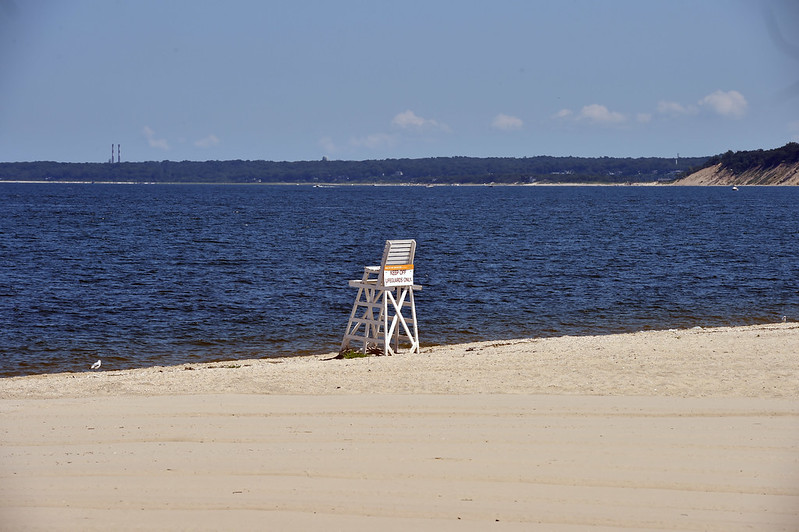
The current crisis reminds us of the past and warns us about the future (photo: Kevin P. Coughlin/Governor's Office)
Everyone on Long Island remembers how it felt during Hurricane Sandy. We were paralyzed, waiting for the storm to pass, fearing for our families, homes, and basic needs. When the skies finally cleared, and we saw the scale of the destruction, it was clear that no individual one of us was strong enough, connected enough, or resourced enough to recover alone. We needed each other, we needed our community, we needed to come together.
Now, we’re facing another disaster, this one a global pandemic that has already sickened millions, killed hundreds of thousands, and left one in five Americans unemployed. We need to remember those lessons learned after Sandy. We must understand that we’re in this together.
The people who were struggling the most to get by before the pandemic started are the ones suffering the most now. Hourly and gig economy workers, the elderly, incarcerated and homeless people, and low-income communities of color are experiencing the most death and economic devastation.
They will also be the ones left behind after the next climate disaster. Long Island is one of the most segregated regions in the country, so it’s no surprise that COVID-19 cases and climate vulnerability are both staggeringly high in communities of color.
Part of this is because of climate and environmental injustice. A new study from Harvard University has found that exposure to air pollution heightens a person’s risk of dying from COVID-19. Here on Long Island, years of housing and environmental policy have ensured that black communities are stuck next to the worst polluting infrastructure sites. It’s no surprise that years of breathing in car and truck emissions can weaken a person’s lungs and make them more susceptible to COVID-19.
We can learn our lesson from Sandy and provide relief now by preparing for the future. Recovery funding and programs should be directed towards the most impacted communities, and should help reduce environmental pollution and thus COVID-19 and other vulnerabilities. As soon as it’s safe to do so, we can put people back to work by building renewable-energy and climate-resilient infrastructure, and target hiring and economic development for communities experiencing the most job and wage loss right now.
And, we can work to avoid the worst climate disasters. Many upcoming climate events are already “locked in,” but we can still come together to avoid the worst of the worst. New York now has one of the strongest climate laws in the country, the Climate Leadership and Community Protection Act. The CLCPA is one of the few laws that calls for emission reductions in line with scientific recommendations to avoid the worst climate outcomes. We can hold our government accountable to the law -- for example, by ensuring it continues to work on the emissions reduction plan during the PAUSE order -- to lessen the risk of worst-case scenario climate disasters in the future.
Reflecting on Sandy in light of the current moment, it’s clear that we did not learn enough about how to come together to keep people safe. People today are dying alone in overcrowded hospitals and nursing homes because our state and federal governments did not take the necessary action to protect people from catastrophe. We cannot let this happen again — not in our lifetimes, and not for our children, either.
As we recover from this pandemic, we must link the recovery with the solutions to the climate crisis. We should be investing in a system that places people before profits and addresses the root causes with bold effective action. We are in this together -- as we have seen, the cost of doing nothing is everything.
***
Lisa Tyson is Director of the Long Island Progressive Coalition, which works for racial justice, building community wealth, and realizing a just transition to a renewable energy future. On Twitter @LisaTysonLIPC.
***
Have an op-ed idea or submission for Gotham Gazette? Email This email address is being protected from spambots. You need JavaScript enabled to view it.
As Construction Sites Reopen, Access to Safety Training Must Too
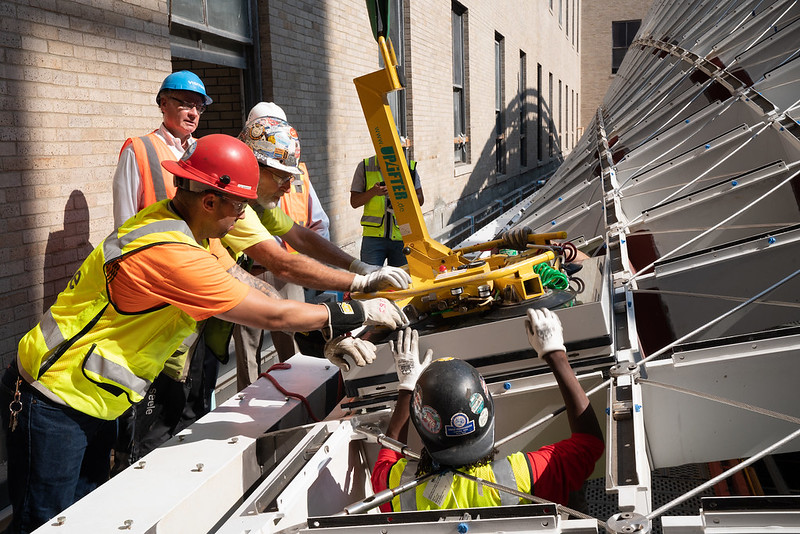
Construction workers will be among the first back to work (photo: governor's office)
In the blink of an eye, COVID-19 brought most of New York City’s construction industry to a halt, leaving thousands of hardworking individuals jobless and struggling to make ends meet. Fortunately, Governor Cuomo recently announced a phased plan to reopen the construction industry, which will create an increased demand for workers.
But we can’t forget that as a requirement for employment in New York City’s industry, many construction workers and job applicants will need to complete additional safety training requirements.
Local Law 196, which required construction workers to have 30 hours of Occupational Safety and Health Administration (OSHA) safety training by December 2019, also requires workers to get an additional 10 hours of training – a total of 40 hours – by this September. That’s just a few months away – and thousands of current or prospective workers still need to meet the deadline.
Prior to the first deadline, Building Skills New York partnered with a wide array of local non-profits and other institutions, such as Hostos Community College and Public Housing Communities, to host OSHA-30 training sessions that helped provide free training to more than 300 workers. And of course, we were far from the only ones stepping up. That kind of work all across the city had a real impact on ensuring that more men and women entering the industry had the training and credentials needed to secure good jobs.
But now, with social-distancing mandates in place for the foreseeable future, it is not currently possible to receive OSHA training in a traditional classroom setting. That’s why it is critical for public and private sector partners to take two steps on this issue over the coming weeks.
First, more funding should be made available to connect current and prospective construction workers with virtual OSHA training opportunities. Workforce development groups like Building Skills are already doing this by shifting our digital operations and using remote technology capabilities to hold online OSHA sessions. Amid current virus concerns, this virtual training model is a no-brainer – it protects workers’ health while also giving individuals full access to construction employment opportunities.
Second, public officials should consider taking careful, data-driven steps to planning out a process for reopening in-person site safety training facilities. While OSHA sessions can be held online, other courses – such as the Department of Buildings’ series of 4-hour, 16-hour, and 32-hour scaffold trainings and the Fire Department’s F-60, G-60, S-92, S-93, and S-94 – must be completed in person. Just as state leaders have developed reopening plans for construction and other industries based on guidance from health experts, the same approach could be applied to spaces that previously housed safety training sessions.
Regardless of how we get there, it is incredibly important that nonprofits and other organizations are able to fund any necessary training sessions over the coming weeks and months. As we look to rebuild New York City’s economy, we must take into account individuals who live in underserved communities with an existing history of unemployment and underemployment. Current and prospective workers from across the five boroughs deserve the chance to access the city’s construction sector as new jobs become available.
Despite the city’s current site shutdowns, the construction industry will soon continue to provide real career opportunities for New Yorkers of all backgrounds. And just as public officials have taken a logical, systematic approach to reopening worksites, they must also look to make safety training more accessible to the men and women who will help build the future of our city in the wake of the COVID-19 pandemic. New funding for virtual courses is a great way to help us do that.
Building Skills looks forward to effectively confronting this new challenge alongside our incredible network of industry and non-profit partners – and we know that these efforts will help ensure that challenge is addressed for workers who need our support.
***
David Meade is Executive Director of Building Skills New York. On Twitter @BuildSkillsNY.
***
Have an op-ed idea or submission for Gotham Gazette? Email This email address is being protected from spambots. You need JavaScript enabled to view it.
Underappreciated and Underserved, Immigrant New Yorkers Need the City to Step Up
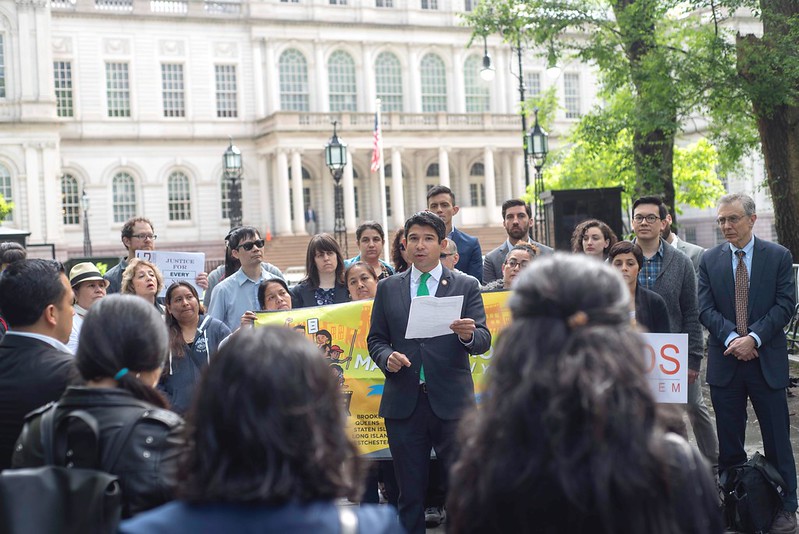
Council Member Carlos Menchaca, the author (photo: John McCarten/City Council)
As in past crises, immigrant New Yorkers are suffering acutely under COVID-19: this time with a cruel twist. While thousands of immigrants work on the frontlines, caring for the sick, cleaning the subways, and keeping us all fed in quarantine, so many are unable to pay rent, keep their businesses afloat, or stay home because of their exclusion from federal relief programs.
That hypocrisy alone should warrant intervention by New York state government, yet it hasn’t. Governor Cuomo has either blamed the federal government for not giving enough aid, or incorrectly claimed, as he did this week, that “the federal government has a number of programs to address” the plight of immigrants already.
The state’s lack of urgency reflects values and priorities as much as fiscal reality. But our city cannot afford to wait for the state to help more than 3 million of our own New Yorkers. We must have the courage to pass a budget that addresses their desperation, primarily because the city’s full recovery depends on it.
In New York City, more than half of immigrants are essential workers, immigrants own half the city’s businesses and contributed $232 billion last year to our GDP. That includes 360,000 undocumented immigrant workers and 48,000 undocumented business owners. A city budget -- due by July 1 -- that excludes immigrants from relief would be astonishingly hypocritical on this basis alone.
It would also be cruel. According to a survey recently conducted by Make the Road New York, nine out of ten immigrant households have at least one earner who has lost a job or income since the pandemic began. Of unemployed respondents, 88% are out of work because of COVID-19. With nine in ten immigrants also renters, more than half were unable to pay rent in April, and nearly every respondent worries they cannot pay in May.
Compounding this economic insecurity is lack of access to government assistance, as undocumented immigrants were largely excluded from federal relief – such as paid sick leave and unemployment benefits – even though they pay billions, annually, in taxes. Of those surveyed, only 15 percent reported receiving any support from the government at all.
Above all, the Trump Administration’s anti-immigrant agenda has proved to be a death sentence for our communities: pre-pandemic expansion of the public charge rule and escalation of immigration enforcement have caused many immigrants to shirk medical care, which puts everyone at risk. All the while, ICE continues to arrest and detain immigrants in COVID-19 infested facilities and the U.S. Department of Justice forces immigration courts to remain open for detained dockets, putting both immigration agents and public defenders at risk.
There is much New York City can do through the budget to help immigrant New Yorkers. Our current situation has exposed the critical gaps our budget fills: funding public defenders for the deportation defense of unaccompanied minors and detained adults; English proficiency classes for New Yorkers to navigate city life and government at all levels; and healthcare programs that are immigrant-led through trusted community partners, to name a few. We must fully renew funding for all immigration legal services and adult literacy programs; allocate funding for culturally sensitive health and mental health-care, and interpretation services like a worker cooperative language bank.
We can also pass existing legislation that would reform our commercial rent market; legalize e-bikes for delivery workers now that state authorization exists; and reform and expand our street vendor licensing system. These bills already enjoy overwhelming City Council support and their passage would send a clear message to immigrant New Yorkers that the city has their backs.
None of these things would come easy, and I appreciate, as a member of the Council’s Budget Negotiating Team, the competing priorities with which we are faced. But immigrants are not a special interest. If we do not secure the well-being of over 3 million New Yorkers, there is no recovery.
It is time for all levels of government to step up and recognize what over 120 grassroots-led mutual aid groups already know: that full recovery depends on the well-being of our immigrant communities. That praise for essential workers is hollow if we exclude most of their ranks from relief. And worse of all, we make a mockery of our collective effort if we leave so many behind.
***
City Council Member Carlos Menchaca represents parts of Brooklyn and chairs the Council’s immigration committee. On Twitter @CMenchaca.
***
Have an op-ed idea or submission for Gotham Gazette? Email This email address is being protected from spambots. You need JavaScript enabled to view it.
What New York City Voters Need to Know About the June Primary Elections
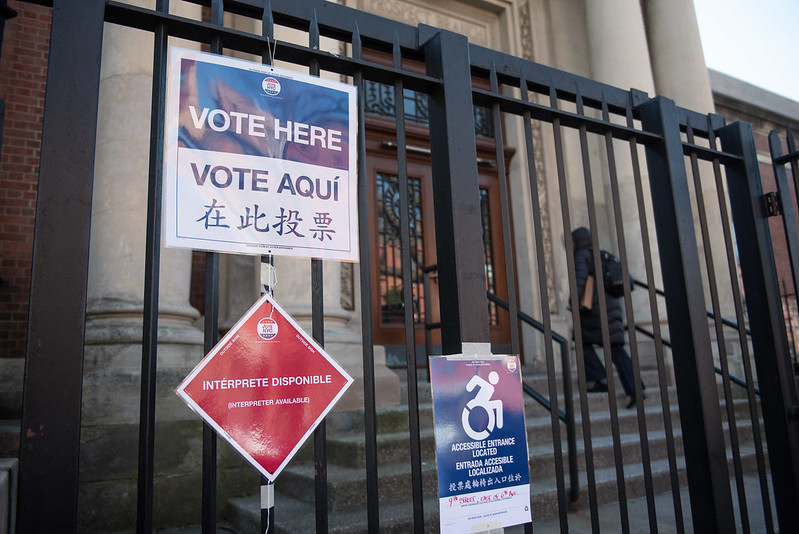
What voters need to know to vote in June (photo: Michael Appleton/Mayor's Office)
The images of Wisconsin voters standing in line last month starkly illustrated how COVID-19 has triggered a health emergency for our democracy. Here in New York, elections have been postponed or canceled in response to the pandemic. We are taking the first steps towards voting in a new way, via mail-in absentee ballots. With all of these rapid changes, it is no wonder voters are confused about what steps they can take to cast a vote safely and help maintain the health of our democratic system.
In response to these unprecedented circumstances, the Mayor’s DemocracyNYC Initiative and the NYC Votes/Campaign Finance Board have convened a consortium of community-based organizations, good government groups, and advocates to get the word out about voting safely to the hardest-hit communities. Our goal is to make sure voters in these underrepresented communities have the information they need to make use of absentee voting as a safe and effective alternative.
Here is the critical guidance New Yorkers need to safely exercise their right to vote -- and to keep our democracy healthy -- on June 23.
First, all eligible voters may cast a ballot by mail. To do so, city voters must request an absentee ballot by June 16. The Board of Elections will mail voters an absentee ballot application this month with a postage-paid return envelope. But there is no reason to wait. We encourage as many voters as possible to request an application online. Requests can be made online at a new website created by the city’s Board of Elections: nycabsentee.com. The application is now available in Spanish, Chinese, Bengali, and Korean.
Absentee ballots will not be mailed out to all voters; only voters who request an absentee ballot will receive one. Thanks to an executive order from Governor Cuomo, anyone who wants to vote absentee due to the coronavirus pandemic should indicate “temporary illness” as the reason for requesting a ballot.
Voting by mail is a safe and effective way to exercise the right to vote during this public health crisis. Governor Cuomo’s executive order allowing all voters to cast a mail-in ballot means New Yorkers will not face the awful choice between voting and protecting their own health that voters in Wisconsin were forced to make.
As New York contemplates re-opening, in-person voting will be available for the voters who need it. The best way to vote in-person is during the early voting period, June 13-21, when fewer people will be at the poll sites. For the health and safety of everyone, especially poll workers, those who can should vote by mail-in ballot.
The second critical point is that primary elections are happening, whether the Democratic presidential primary is held or not (that matter is currently being decided by the courts). Important primary races for Congress, State Legislature, and municipal offices will be decided on June 23. The vast majority of neighborhoods across the city will have at least one primary contest on that absentee ballot.
To vote in most primary elections, voters must be enrolled in the party holding the primary under rules set by the parties. The state’s look-up tool (voterlookup.elections.ny.gov) is the best way to check whether your voter registration and party affiliation status makes you eligible to vote in a primary.
While the path is clear to vote safely by mail in June, we are concerned that New Yorkers will not have that option in November. Governor Cuomo’s order making the risk of contracting coronavirus a valid excuse for voting absentee will expire after the primary election. These changes should be considered for future elections to allow safe and secure voting in November.
Voters should not have to choose between health and enjoying the privileges of citizenship. In time of crisis, it is critical New Yorkers participate in choosing who will lead our city in the coming months and years of rebuilding. We urge all eligible voters to request a mail-in ballot and be a part of making those critical choices on June 23.
The undersigned civic leaders are launching a nonpartisan outreach campaign this week to guide New York voters through the 2020 elections. New Yorkers can request an absentee ballot for the June primaries online at www.nycabsentee.com. To request a ballot by phone, or for help with voting questions, call the Board of Elections hotline 866-VOTE-NYC (1-866-868-3692).
|
Name |
Title |
Organization |
|
Wayne Ho |
President & CEO |
Chinese-American Planning Council (CEC) |
|
Betsy Gotbaum |
Executive Director |
Citizens Union |
|
Prof. Ester Fuchs |
Director |
Columbia University, WhosOntheBallot |
|
Edward Cuesta |
Executive Director |
Dominicanos USA |
|
Eliana Santos |
Director |
Dominicanos USA |
|
Laura Ladd Bierman |
Executive Director |
League of Women Voters of NYS |
|
Karen Cummings |
Community & Govt Affairs Liaison |
LiveOnNY |
|
Laura Wood |
Senior Advisor & General Counsel |
Mayor's DemocracyNYC Initiative |
|
Bitta Mostofi |
Commissioner |
Mayor's Office of Immigrant Affairs |
|
John Park |
Executive Director |
MinKwon Center for Community Action |
|
Amy Loprest |
Executive Director |
NYC Campaign Finance Board |
|
Dr. Sarah Sayeed |
Chair & Executive Director |
NYC Civic Engagement Commission |
|
Megan Ahearn |
Program Director |
NYPIRG |
|
David Estrada |
Executive Director |
Sunset Park Business Improvement District |
|
Jarret Berg |
Co-Founder |
VoteEarlyNY |
***
Have an op-ed idea or submission for Gotham Gazette? Email This email address is being protected from spambots. You need JavaScript enabled to view it.
Let’s Thank All Caregivers, Not Just the Most Visible
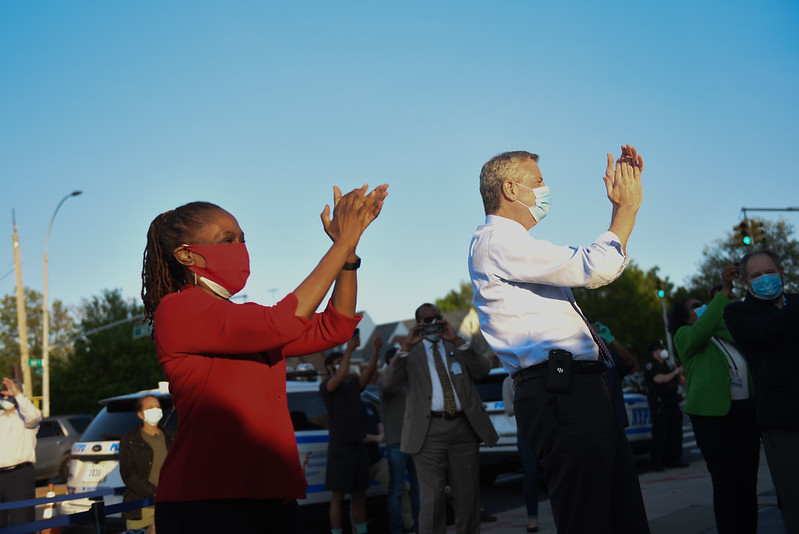
Thanking all caregivers is essential amid the pandemic (photo: Michael Appleton/Mayor's Office)
Long-term care is the fastest growing sector within the health-care industry in New York City, and with 1.2 million New Yorkers now over the age of 65, it will only continue to grow in size and importance over the next 10 years.
Nevertheless, this vital health-care workforce remains largely invisible as most paid long-term care services are provided by direct care workers to homebound individuals. Sadly, when it comes to long-term care, out of sight often means out of mind.
It’s time for our direct care workers — including home health aides, personal care attendants, direct support professionals, and certified nursing assistants — to get the respect and support they deserve. As the lowest-paid workers in the health-care system, typically earning just $21,000 a year, they perform strenuous, isolated work, often without benefits or opportunities for advancement.
Predominantly people of color and immigrants, they too have been rising to the challenge as they continue to care for hundreds of thousands of older people and people with disabilities in their homes and in nursing facilities through the COVID-19 pandemic.
These efforts have clearly helped to reduce the surge in hospitals. Yet, unlike doctors and nurses, who have deservedly received public recognition for their sacrifices, direct care workers have largely been left out of the conversation.
Despite these systemic challenges, there have been some signs of progress amid the COVID-19 pandemic. New York City has designated direct care workers as essential workers, is helping to supply them with personal protective equipment, has opened testing centers for these workers, and has made them eligible for hotel rooms should they need to self-isolate. Recently, the city partnered with One Medical to offer COVID-19 testing and telehealth services, and will prioritize 1199SEIU members and essential workers, many of whom work in long-term care.
Before COVID-19 challenged our systems, city government partnered with the New York Academy of Medicine (NYAM) to convene direct care providers, trade associations, and Local 1199SEIU (which represents approximately 103,000 direct care workers) to better understand and elevate the value of direct care workers in long-term care.
The strategies we developed to address training and recruitment, career pathways, better integration of direct care workers in health-care systems, improved Medicare/Medicaid reimbursement rates, and expanded rights and resources for the direct care workforce are more important than ever before. There is a lot of work left for us to do and it will not be easy. But in the interim, let’s start with the number one issue identified by both workers and providers: Respect.
As COVID-19 forces the nation to rethink and reform its approach to health care, direct care workers must be included as a critical part of a reimagined health-care system. For now, let us celebrate New York City’s direct care workers, and thank them for their service.
***
J. Phillip Thompson is New York City Deputy Mayor for Strategic Policy Initiatives and Judith A. Salerno, MD, MS, is President of The New York Academy of Medicine. On Twitter @NYCMayorsOffice, @DrJudySalerno, & @NYAMNYC.
***
Have an op-ed idea or submission for Gotham Gazette? Email This email address is being protected from spambots. You need JavaScript enabled to view it.
A Bad Deal at the Municipal Credit Union
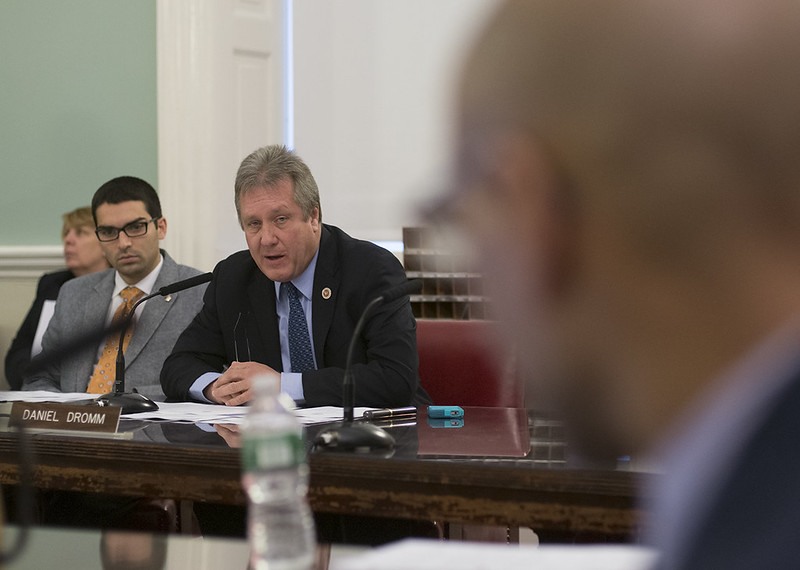
Council Member Dromm, the author (photo: William Alatriste/New York City Council)
As we confront the COVID-19 pandemic in New York, millions of residents face serious financial insecurity, and are worried about how they are going to pay their bills. They are worried about themselves and their loved ones getting sick or not being able to work due to the social distancing regulations in place.
For workers at Municipal Credit Union, the largest credit union in New York, the crisis has only made recent negotiations between management and the union representing them worse.
Over 500,000 city workers depend on MCU for their banking needs, including mortgages, car loans, and checking and savings accounts. Nearly 400 union MCU workers are working hard to ensure that New Yorkers have access to their finances at this crucial and challenging time, but they are also facing the risk of exposure. They need to be assured protection and treatment should they get sick. Many MCU employees have reported that they are not being supplied with enough masks, forcing them to reuse the ones they do get and putting them at higher risk of contraction.
While all of this goes on, I understand from the workers that MCU management is now attempting to take away sick days, increase health-care premiums, and raise deductibles. These decisions will cost MCU families thousands of dollars more each year to ensure they have access to health care. It is another attempt in a long line of recent actions by MCU management to weaken employee rights. Recent layoffs without union agreement have also meant that there is even less staff to handle the important work that must be done at this moment.
Last year when the New York State Department of Financial Services took possession of MCU following massive embezzlement by the CEO, things were supposed to turn around. However, they have only gotten worse for hardworking employees. Following the Department's appointment of the National Credit Union Association as conservator and its appointment of the Consultant Management Team to help operate the credit union through conservatorship, Jackson Lewis, a law firm known for their union-busting tactics, was hired.
Over the last few months, the union has repeatedly requested the ability to bargain over multiple days, and so far there has been refusal to bargain more than one day a week. There have also been questions about Jackson Lewis’ authority to bargain, and when union representatives asked about this authority, the attorney’s response was that the union should file an unfair labor practice charge. These kinds of tactics are hurting workers everyday, making it more difficult for them to provide the essential services needed.
While MCU employees make sure that New Yorkers can walk into a branch and take out money to pay their bills, high-priced attorneys are making thousands of dollars with the goal of permanently damaging workers’ rights. It is just not right.
We face extraordinarily difficult times, and the hardworking OPEIU members who make up MCU should not have to worry about sick time during this COVID-19 pandemic, or their health-care and jobs. It is time for the NCUA, CMT, and MCU management to do the right thing and put an end to these attempts to slash sick time and increase health-care premiums at a time when these essential workers are needed more than ever.
***
City Council Member Daniel Dromm represents parts of Queens and is the Council’s finance chair. On Twitter @Dromm25.
***
Have an op-ed idea or submission for Gotham Gazette? Email This email address is being protected from spambots. You need JavaScript enabled to view it.
From the Front Lines: A Respiratory Therapist’s Plea for the Next COVID-19 Package
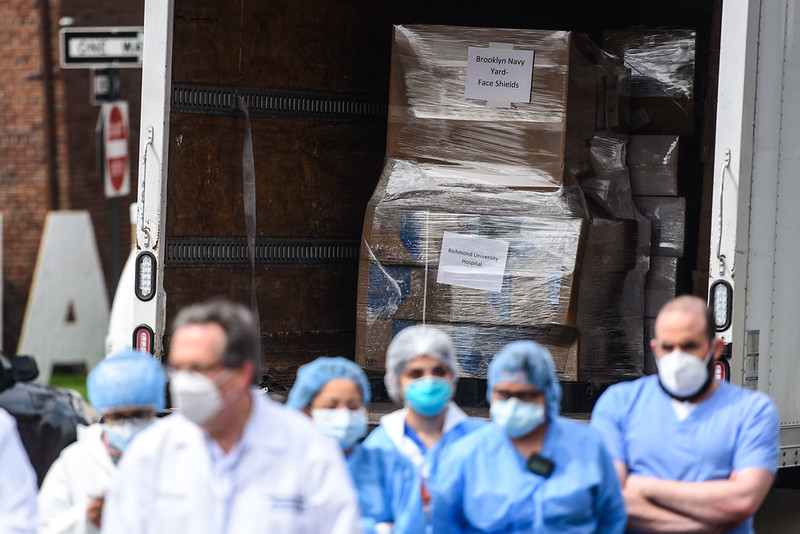
A frontline health-care worker on what's needed next from DC (photo: Michael Appleton/Mayor's Office)
It has been a challenging, frightening time for everyone, but especially for those of us working in health care. Amid all the suffering and anxiety brought about by COVID-19, health-care workers on the frontlines have continued to show up and display strength, faith, and courage in taking care of the most vulnerable.
During these difficult times, I have never seen such dedication displayed by my co-workers in health-care facilities across New York City and throughout the state. At times overwhelmed, emotional, and exhausted as the surge of the virus engulfed us, I’ve never regretted the career path I have chosen.
In 1997, I migrated from Trinidad to New York City and pursued a career in health care as a Respiratory Therapist. During my 18 years as a therapist, I have intubated and managed countless patients on a ventilator at my hospital in Brooklyn. But all of my education and experience has been tested by the challenge of this pandemic.
On a daily basis my co-workers and I experience a massive influx of critically ill patients, each exhibiting new and unexplained symptoms. Brooklyn has had more than 50,000 cases of COVID-19 alone. Additionally, we are all managing the daunting task of caring for our own families and co-workers who are threatened by COVID-19.
The people at my hospital and medical professionals around the state – many of whom, like me, are proud members of 1199SEIU – are committed to delivering the same high standard of quality health care, regardless of this outbreak. But to do that, we need every piece of our health-care delivery system doing its part: health-care workers, health-care facilities, health insurers, our community, and state and federal government.
The heartfelt thanks and gratitude we have received from our communities – including the nightly rounds of applause – have been overwhelming and are greatly appreciated. But these words cannot save lives. To provide the needed care at this critical and challenging moment, my frontline colleagues and I need help. In particular, we need the federal government to provide the financial assistance that my co-workers, our patients, and our state need to deliver quality health care.
As they continue to discuss the next stimulus package, Congress and President Trump need to do the following:
Personal Protective Equipment (PPE): Whether they’re working in a hospital, clinic, nursing home or delivering home care, all frontline workers must have enough personal protective equipment (PPE) to keep themselves – and their patients – safe. It’s frustrating for me and my colleagues that Congress could ever think this is up for debate. We can’t deliver great care if we can’t protect ourselves from the diseases we’re fighting each day.
Crisis Pay: Frontline healthcare workers who are risking their lives every day they go to work should receive some sort of premium pay that recognizes their courage and the sacrifices they make day in and day out.
And as offices and schools alike are closed, many parents are juggling working from home while caring for their children. This is no doubt a challenging task. But for parents like me and many of those I work with, working from home is not an option, and the unexpected costs of finding daycare for our children have added a financial burden to the physical and emotional burdens we’re undergoing.
Medicaid Funding: Medicaid covers a third of New Yorkers, including millions of children and seniors. As the pandemic continues and unemployment skyrockets, more and more New Yorkers need that coverage. Our Medicaid program is already stretched to the limit and is about to break unless the federal government does its part and provides more funding for this critical program. If our hospitals don’t survive, our patients don’t. Medicaid funding is essential for us to continue doing the work we’re doing to battle this crisis.
In recent days, we have begun to see the light at the end of this tunnel. But our work is far from done.
The next COVID-19 relief package is being negotiated on Capitol Hill right now and must address the lack of resources across New York. If we get the support we need and deserve from Congress and the Trump administration, together we will win this health-care battle. We, as frontline health-care workers, are committed to do our job. Congress and the President have to do theirs.
***
Allison Trubett has worked as a respiratory therapist in Brooklyn for 18 years. She is a member of 1199SEIU United Healthcare Workers East.
***
Have an op-ed idea or submission for Gotham Gazette? Email This email address is being protected from spambots. You need JavaScript enabled to view it.
Carbon Free Is How We Build Back From COVID-19
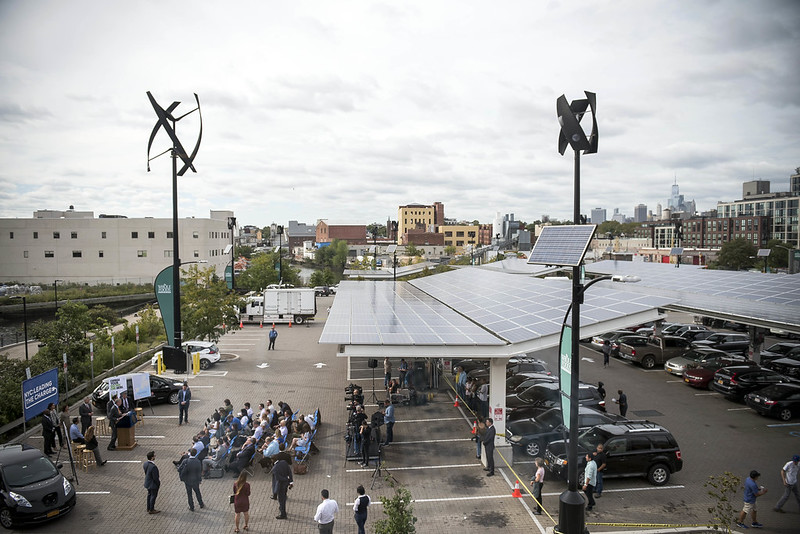
Is the post-coronavirus future renewable? (photo: Ed Reed/Mayor's Office)
There have been many hard-learned lessons from COVID-19, but by far the most tragic – paid for with the lives of tens of thousands of people – is that when it comes to dealing with a public health crisis, preparation and proactive planning is the only approach that can keep our worst nightmares from becoming a reality. While New York is still far from reaching the light at the end of the tunnel, many inside and outside of government have rightly begun to envision what a restart to our economy should look like.
It is in this conversation that we have a unique opportunity to get the restart right by appropriately investing in a cleaner, greener, and more energy-resilient economy that will have the dual benefit of driving much-needed job and economic growth statewide while also helping fortify our defense against the next impending crisis for which there can be no vaccine – that of climate change and its impacts. By ensuring that governments like New York State make our long-term climate change goals a priority as part of the economy-wide restart, we can meet our immediate economic and public health concerns, as well as better position our renewable and clean energy industry to reach our broader climate change goals.
While the public health concerns and dangers of coronavirus are very serious and science should be the determining guide for any economic recovery plans, we shouldn’t lose sight of the climate crisis and how these goals are inextricably linked. New York residents are clearly being harmed by a changing climate caused by carbon emissions, with unequal impacts on the state’s most vulnerable and disadvantaged communities. By starting anew with a clean energy economy, we can expect to greatly reduce the risk of the increasingly serious effects of climate change.
The evidence of New York’s changing climate are readily apparent across every region of the state: a 74% increase in extreme precipitation since the 1950s; an increase in extreme storms like superstorm Sandy, which cost $40 billion in reconstruction and tourism losses; extreme drought in the Finger Lakes; flooding along Lake Ontario’s shoreline; and overwintering pests destroying our forests and crops. Sea level rise is also impairing coastal communities and infrastructure such as airports and sewage treatment plants. Flooding disrupts communities, agriculture, and water quality. New York State’s temperature has increased 2.6 degrees Fahrenheit since 1897. Action is clearly warranted.
Unfortunately, the federal government has abdicated its responsibility to protect the environment; a recent New York Times analysis found that of more than 90 environmental rules and regulations rolled back under the Trump Administration during the last three years, 16 concerned air pollution and emissions.
Without sufficient action at the national level to enact any kind of impact solution to climate change, like a national carbon fee and dividend, it’s up to each state to implement clean energy policies. Governor Cuomo has thoughtfully proposed a gradual approach to reopening the economy, with lower risk activities beginning before others and the private sector doing its part by adjusting to minimize the risk of spreading the coronavirus. That same logic – with New York seeking to implement its own plan irrespective of federal inaction – can and should be applied to investing in carbon-free policies that can help restart our “clean” economy in a safe manner while also advancing climate crisis goals.
New York has always been a national leader in fighting the climate crisis. Last summer, the state enacted the Climate Leadership and Community Protection Act, a historic climate law that calls for 70 percent of the state’s electricity to come from renewable energy by 2030 and 100 percent of the state’s electricity supply to be emissions-free by 2040.
In an effort to reach those goals, the New York Independent System Operator (NYISO) has proposed a carbon-pricing plan. Nearly all leading economists agree that carbon pricing -- which puts a price on carbon emissions to disincentivize such pollution and fund clean energy projects -- is the most efficient single step we can take to significantly reduce greenhouse gas emissions. Furthermore, it costs the government virtually nothing, hits nearly every sector of the economy, and protects consumers from rising energy costs.
Citizens’ Climate Lobby New York (CCLNY), a nonprofit, nonpartisan, grassroots advocacy organization and member of the Carbon Free New York coalition, fully endorses the NYISO carbon pricing plan. If enacted, the plan will reduce carbon emissions in the electricity sector by 22 percent and generate up to $691 million in annual economic benefits by 2025.
According to a report by the Alliance for Clean Energy, the NYISO plan will not only accelerate the pace at which the state moves towards its goals for 2030 and 2040 laid out in the Climate Leadership and Community Protection Act, but it will also demonstrate to the world New York’s ability to integrate aggressive environmental goals with a competitive market structure. And it will amplify the renewable energy industry, reducing pollution in a densely populated area, while positively impacting public health outcomes – goals that have become even more important to our recovery from the COVID-19 crisis.
For a safer and healthier New York, we must be carbon free.
***
Lynn Meyer is New York State Co-coordinator for Citizens' Climate Lobby (CCLNY), an international nonpartisan volunteer organization that advocates for federal carbon fee and dividend legislation and a member of the CarbonFreeNY coalition.
***
Have an op-ed idea or submission for Gotham Gazette? Email This email address is being protected from spambots. You need JavaScript enabled to view it.
Surveillance and the City: Public Trust Needed for a Public Tracing System
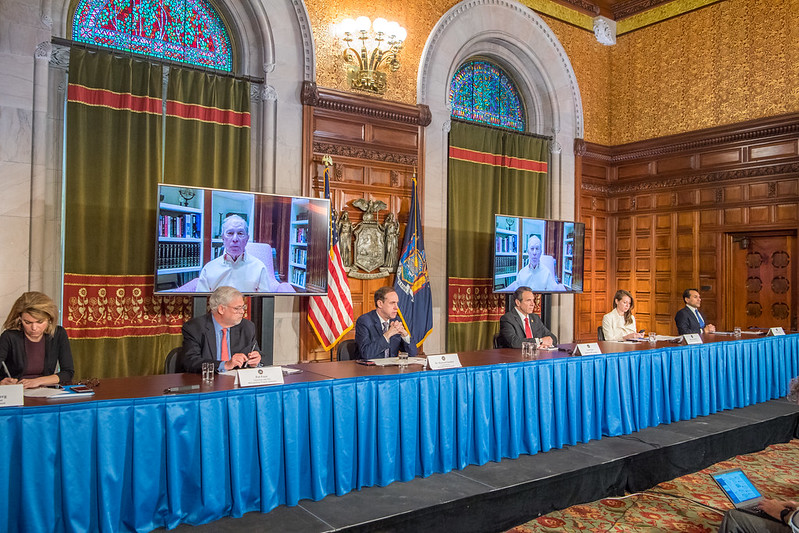
Bloomberg and Cuomo team up on contact tracing (photo: Darren McGee/Governor's Office)
The scene sounds familiar: Michael Bloomberg overseeing thousands of officials tracking where New Yorkers go and who they spend time with, all in the name of keeping us safe. In 2010, it was then-Mayor Bloomberg overseeing tens-of-thousands of NYPD officers as they stopped and frisked New Yorkers of color and spied on Muslim student groups and mosques. In 2020, it’s Bloomberg the philanthropist, helping to run the unprecedented effort to contact-trace the spread of COVID-19.
There’s a lot we don’t know about the state’s contact-tracing partnership with Bloomberg: who will have access to the data, how will data be kept, when (if ever) can data be shared with police. But there is a lot we do know about Bloomberg, facts that should give us pause about entrusting the most important public health effort in generations to the man who thought American Samoa’s presidential delegates were worth nearly $200 million.
Throughout his time as Mayor and short-lived presidential run, Bloomberg was a self-proclaimed stats guy, the man famous for saying: “In God we trust, all else bring data.” But for Bloomberg, data has a dangerous way of showing him what he already believes. Bloomberg views statistics with a Wall Street hubris, the mindset of the financial titans who assure us that they know exactly how to manage risk up until the moment everything crashes and they ask for the next bailout.
The truth is that data about human beings is almost inevitably biased, warped by countless subjective decisions that go into creating the data set. In finance, it was the logic of redlining that decided black homeowners were too risky to lend to, thereby depriving them of loans, and creating the self-fulfilling prophecy where many capital-starved black neighborhoods then saw higher rates of foreclosure after they were forced to turn to predatory lenders. It was the logic of stop-and-frisk, the racist policing practice that Bloomberg defended until the precipice of his presidential campaign, claiming “we put all the cops in minority neighborhoods. Yes, that’s true. Why do we do it? Because that’s where all the crime is.”
The problem is that communities of color weren’t the only place that “crime was,” it was just the only place where many laws were enforced. Looking back at my own lower Manhattan childhood, the reality is stark. Whether it was open container violations, drug possession, or other low-level offenses, we had these in abundance in wealthy white neighborhoods. The only difference is that no one was stopped for them, and thus the crime data showed they weren’t happening.
History is why so many New Yorkers want safeguards and answers before the Bloomberg partnership goes forward. At a time when the cash-strapped state is digging beneath the proverbial couch cushions for every spare penny, having Bloomberg finance the tracking program will come as a financial relief. But for contact tracing to be effective, Albany will need something more elusive than even Bloomberg’s billions: public trust.
Without public trust, without our willingness to hand over the most intimate details of our lives to a complete stranger, contact tracing will hit a dead end. Our ability to track disease is only as strong as the public’s ability to help. But rather than bending over backwards to reassure New York’s most vulnerable and potentially reluctant residents, the state’s leaders are dismissing the concerns out of hand.
When Public Advocate Jumaane Williams sent a letter to Governor Cuomo, asking for reassurances about Bloomberg’s role in the tracking program, the response was less than receptive. Rather than giving the city’s top civil rights watchdog the details requested, Cuomo’s spokesperson dodged most of his requests before saying “There’s enough real problems fighting this pandemic, and we have no time for politicians who create fake ones in a craven attempt to get in the paper.”
But that’s precisely the problem: privacy is already a part of the fight against the pandemic. If the Governor can’t give a clear and direct response to questions like, “who has access to the data,” then how can New Yorkers be expected to provide that data in the first place?
Throughout the COVID crisis, the Governor has doubled down on his impulse to act unilaterally. Some of those decisions have helped safeguard the state, but others have likely cost us lives and wasted millions (if not billions) in public funds. But this is a part of the COVID battle that Cuomo can’t fight on his own. A trusted, inclusive, culturally-competent contact-tracing system will require unprecedented public support.
If we go forward with Bloomberg at the center of the effort, then it will put even more pressure on state leaders to win the public’s trust. If we disclose all the details possible, create the strongest privacy safeguards in the country, and have a sustained public engagement campaign, then this might all just work. But if we don’t act now to prove to the public why this scheme is safe, then not even Bloomberg’s checkbook will be enough to erase his checkered privacy past.
***
Albert Fox Cahn is the executive director of The Surveillance Technology Oversight Project at the Urban Justice Center, a New York-based civil rights and privacy organization. He writes the monthly "Surveillance and the City" column for Gotham Gazette. On Twitter @FoxCahn.
***
Have an op-ed idea or submission for Gotham Gazette? Email This email address is being protected from spambots. You need JavaScript enabled to view it.
Governor Cuomo Owes Subway Riders and Homeless New Yorkers A Housing Plan
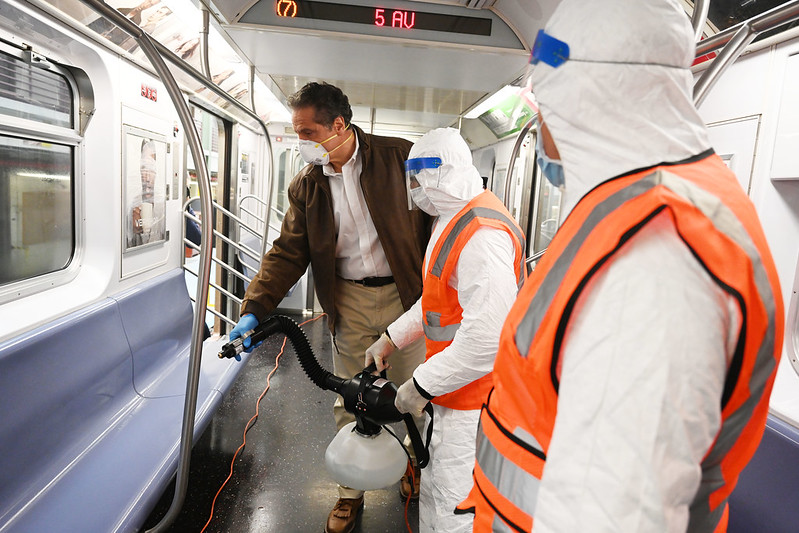
Governor Cuomo disinfects a subway car (photo: Kevin P. Coughlin/Governor's Office)
The subway is New York’s circulatory system. If it doesn’t recover, New York won’t. But reopening the subway and the city means more than running more trains: It also means helping homeless New Yorkers who today have nowhere else safe to go.
That is because, as Governor Cuomo demonstrated, the city’s transit crisis is too entwined with its housing crisis for the MTA alone to bring the subway back. In response to the rising number of New Yorkers with no choice but to seek shelter underground, the governor took the most dramatic step he’s taken since putting the state on pause: closing the subway system between 1 and 5 a.m. each night.
The end of 24-hour-a-day subway service made international headlines. In a cruel twist of irony, New York may no longer be the city that never sleeps and at the same time has one less place for unhoused people here to bed down. But closing the subway will not prevent people from sleeping in the transit system, so long as no other safe options are available. To date, the governor and Mayor de Blasio have refused to offer hotel rooms for homeless individuals on the streets or subways who need safe spaces to socially distance and take care of their basic human needs. Although the Mayor has touted that 1,000 people are being moved from congregate shelters to hotel rooms each week, thousands of homeless New Yorkers still face a heightened risk of contracting COVID-19 in congregate shelters -- and those on the streets and subways are not offered these hotel placements directly.
For several decades, as rents have risen, wages have not kept pace. In the past 15 years, New York City has lost more than a million low-rent units, and housing construction for extremely low-income and homeless households has not kept pace with that loss. That inequitable mismatch has increased the number of people who can’t afford a place to live, whether or not they work. Moreover, the shocking economic and health effects of the coronavirus pandemic have forced newly homeless people onto our streets and into the subways.
While New York City maintains a legal right to shelter, the congregate nature of many shelters is simply not safe, as evidenced by the spread of COVID-19 throughout approximately 171 shelters so far. Homeless New Yorkers on the subways know this and are consciously and reasonably refusing to enter shelters and risk their health.
At the same time, New York City needs 24-hour subway service. A significant number of riders -- many of them essential workers -- depend on the subway for travel between 1 and 5 a.m. and have no other option. Essential workers in health care, food service, building services, and more ride transit overnight while the rest of us sleep. Overnight subway service is essential to restore our 24-hour economy as soon as is safely possible. A full recovery is unimaginable without it.
Meanwhile, daytime service, which moved several million people daily for more than a century until March, will falter if crowding is unmanageable as New York reopens. As more New Yorkers return to work, the ability to maintain social distance on the commute is key. Governor Cuomo must ensure subway riders have more space than before. But to reliably limit crowding and keep both homeless and housed New Yorkers safe, he will also need to safely house people who have had to resort to sheltering inside subway cars.
The answer to homelessness in our transit system is not to drive people off the subway and further into the shadows, further from the help they so desperately need. The answer is to offer them safe temporary shelter and permanent housing. Right now, the city and state are deploying NYPD, MTA Police, and outreach workers to clear trains at night and offer “services.” These services are in the vast majority of cases a transport to an unsafe congregate shelter. Many individuals on the trains are aware of the risks of COVID-19 in shelters and take their chances on the streets instead.
City Council Speaker Corey Johnson and Council Member Stephen Levin recently proposed opening the city’s more than 100,000 empty hotel rooms to homeless people. This sensible option can provide the safe, private accommodations everyone needs to ride out the pandemic. With no indication when tourism will return, allowing homeless individuals on the streets and in the transit system to immediately access hotels is a creative, humane, and efficient way to match surplus with need. It is the right thing to do.
Similarly, state legislators led by Assemblymember Andrew Hevesi and Senator Liz Krueger have long advocated for state-funded housing vouchers to move people off streets, out of shelters and other public spaces, and into homes of their own. The Home Stability Support program and more permanent supportive housing would put state resources behind ending one of the harshest manifestations of life in the most unequal state in the nation.
In the coming weeks, these worthy proposals should form the basis of a housing plan fit for the subway that will keep riders safe. To reopen New York to everyone, around the clock, Governor Cuomo must seize the moment to meet New Yorkers’ housing needs.
***
Danny Pearlstein is Policy Director at the Riders Alliance. Giselle Routhier is Policy Director at Coalition for the Homeless. On Twitter @dannypearlstein & @RidersAlliance & @giselle_ashley & @nyhomeless.
***
Have an op-ed idea or submission for Gotham Gazette? Email This email address is being protected from spambots. You need JavaScript enabled to view it.




